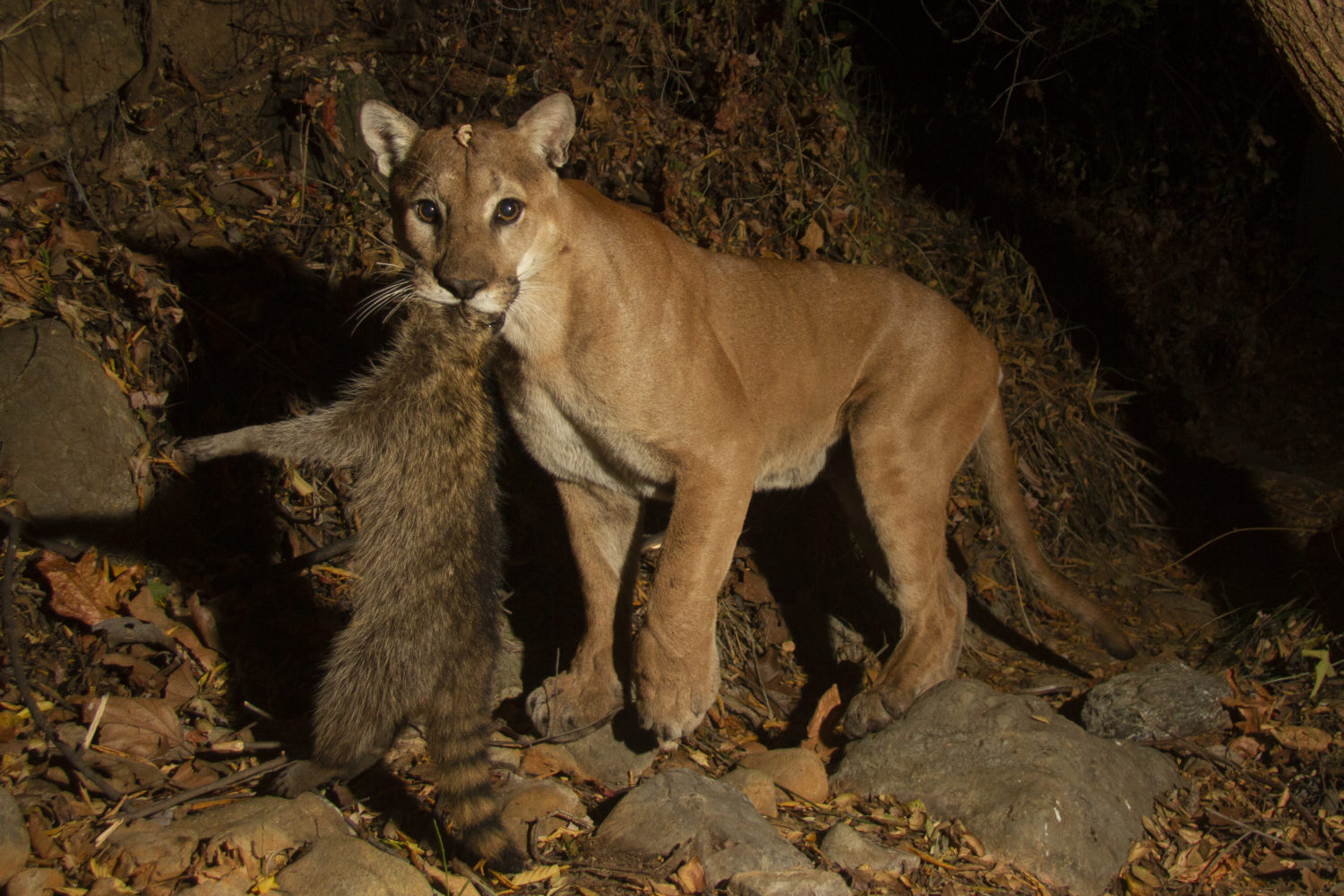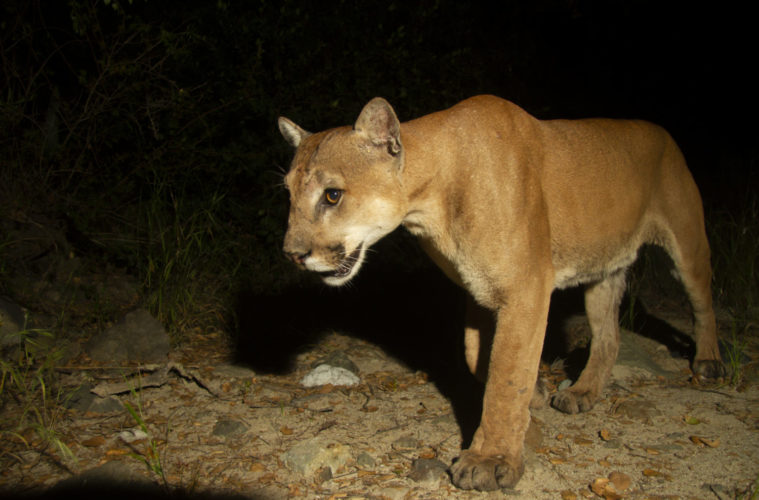As sightings of mountain lions become commonplace in Orange County, the list of urban legends associated with these covert, nomadic cats continues to grow.
Recently, an incident on Tuesday, May 4, left residents in Williams Canyon on edge, after a mountain lion attacked goats inside a livestock enclosure, killing at least one. The mountain lion was subsequently trapped inside the enclosure, unable to free itself after the attack.
In the days following the May 4 livestock attack, familiar rumors began circulating that a rogue mountain lion was responsible and was hunting for sport, not food.
Rebecca Barboza, an Environmental Scientist with the California Department of Fish and Wildlife, the agency that relocated the animal, said it is not uncommon to find multiple carcasses when mountain lions attack captive livestock, due to pandemonium that ensues when a large predator enters an enclosure.
Once inside, the mountain lions may kill more than one animal in the process of selecting the weakest and slowest, she said.
“In an enclosure setting, all of the prey animals are going to panic, so the mountain lion is observing all this panic, so it’s killing all of the animals – just to get the situation calmed down,” she explained.
To free the mountain lion in Williams Canyon, the Orange County Sheriff’s Department enlisted the help of the CDFW to sedate and relocate the animal. Barboza, who has more than two decades of experience as a wildlife biologist, explained that in terms of capture and release protocol, CDFW determines the best course of action on a case-by-case basis.
“Ideally, the best thing for the animal is just to open the enclosure and let it go,” Barboza explained in an interview with Irvine Weekly. “It was thought that for the safety of the animal, as well as the safety of the people – the residents and the staff – that we would immobilize the animal inside the enclosure and take it to the nearest available habitat, and release it that way.”
Still, local researchers say myths of rouge mountain lions are harmful and overshadow the true plight the mountain lions of Orange County are experiencing.
As the lion’s natural habitat continues to shrink due to wildfire and manmade barriers, like freeways and neighborhoods, few pathways exist for the species to expand genetic variation within the local populations.
Now, local mountain lion researchers have grown worried, specifically over the health and well-being of mountain lions within the Santa Ana Mountains.
Dr. Winston Vickers, Director of the Mountain Lion Project at UC Davis, a project that has studied mountain lions in the Santa Ana mountains since 2005, has shown that there are approximately 18-24 lions currently living within the Santa Ana mountains.
He disagreed with the sport-killing mountain lion theory wholeheartedly.
Vickers says regardless of what humans may believe about these cats, the fact is that mountain lions in Orange County are constantly frequenting locations that intersect with human activity, but the animals are largely uninterested in human interaction.
Unfortunately, however, from Vickers’ perspective, the mountain lions within Orange County are currently walking a fine line between survival and extinction, which Vickers fears could become a reality within the next 50 years.
“It’s a very sad story, but very typical of the mountain lions in this mountain range – one of them was poisoned, one was shot, three were hit by cars,” he said. “Every time I tell these stories I just get reminded that really our research, in contrast to most mountain lion research, is mostly researching how they died, as much as how they live. So, it can get pretty depressing.”
Vickers said a female mountain lion, officially known as F121, was killed in the Bond Fire in December, after burning her paws and starving to death.
Vickers, who conducts portions of his research in Irvine, added that he hopes to separate fact from fiction about these animals, emphasizing that reinforcing false narratives about mountain lions causes further damage to the already rocky relationship between mountain lions and humans.
Vickers is currently collecting fur samples from more than 60 “hair snare” traps, which enable researchers to collect hair without being near the animal. Of the half dozen territories within California, Vickers says he is most concerned about mountain lions within the Orange County and greater Southern California region.
“Santa Ana population is the most concerning of all the populations in California, with a close second being the populations within the Santa Monica Mountains, north of L.A. – both populations are severely inbred, and cut off from other populations,” Vickers explained.
Through his research, Vickers has found that inbreeding, along with the lack of natural pathways within Orange County, has severely stunted the local mountain lion populations genetically.
“One thing that was really pointed out was the plight, genetically, of this population. Overall, these years of study and sampling, we’ve only found one animal that came across I-15, from the East to the West, and reproduced,” he said. “It’s almost always the young male responsible for moving the genetic material around. We had detected two others, but they did not reproduce.”
For Vickers, he expected to see at least three or four make the trek from East to West during that same timeframe. If this lack of reproduction trend continues, Vickers fears a tragic road is ahead for these giant felines.
This scenario has led Vickers to a startling statistic.
“We found that if reproduction really began to suffer in this population, and that’s what we’re trying to evaluate now, that this population could go extinct within the next 15 years,” he said. “Even without reproductive problems, it had a moderate likelihood of extinction within a 50 year period, just because of high mortality – so that’s been the really surprising and kind of shocking finding.”

(Mark Girardeau/Orange County Outdoors)
After the capture in Williams Canyon, Mark Girardeau, a well-known Orange County-based wildlife photographer, said he recognized the animal after the landowners sent him photos.
Girardeau explained that the specific male that was captured has a few names which include “Scar” due to a long scar across his hind leg. Girardeau said he has come to call the male mountain lion “El Cobre.”
Girardeau has spent nearly a decade photographing animals in Orange County, and currently has more than a dozen motion-activated trail cameras located on properties within the Orange County mountain ranges.
He said his trail cameras have documented El Cobre several times within the last few months.
“I don’t specifically track him, but I do get him on camera pretty often, in a few spots. There are a couple of other mountain lions I get in a couple of other spots, too,” Girardeau said in an interview with Irvine Weekly. “But, the last year, it’s probably been mostly him.”
Girardeau, and other locals in the area, say El Cobre has been spotted as far south as Ortega Highway, and as far north as Silverado Canyon, which are separated by more than 30 miles.
Now, Vickers says El Cobre’s recent capture has piqued his interest, and he is awaiting the results of genetic research on hair samples collected from El Cobre.
“He’s obviously a little older, he’s pretty scarred – that means he’s survived a while, that’s good news from the survival perspective, maybe he’s been producing kittens, so that’s good if he has been.”
While the data will not be available any time soon, he hopes El Cobre carries enough genetic variation to help with the decreased fertility rates.
“We did get some hair from that animal, that Fish and Wildlife collected, and we’re going to include it in the hair study. If we can get DNA from that hair, we may be able to determine who that male is related to, how he fits into the big picture,” Vickers explained. “Is he an animal that grew up here, or is he maybe an animal that came over from the side of I-15 – we’re really interested in detecting those animals that have crossed the freeway successfully.”
Advertising disclosure: We may receive compensation for some of the links in our stories. Thank you for supporting Irvine Weekly and our advertisers.

